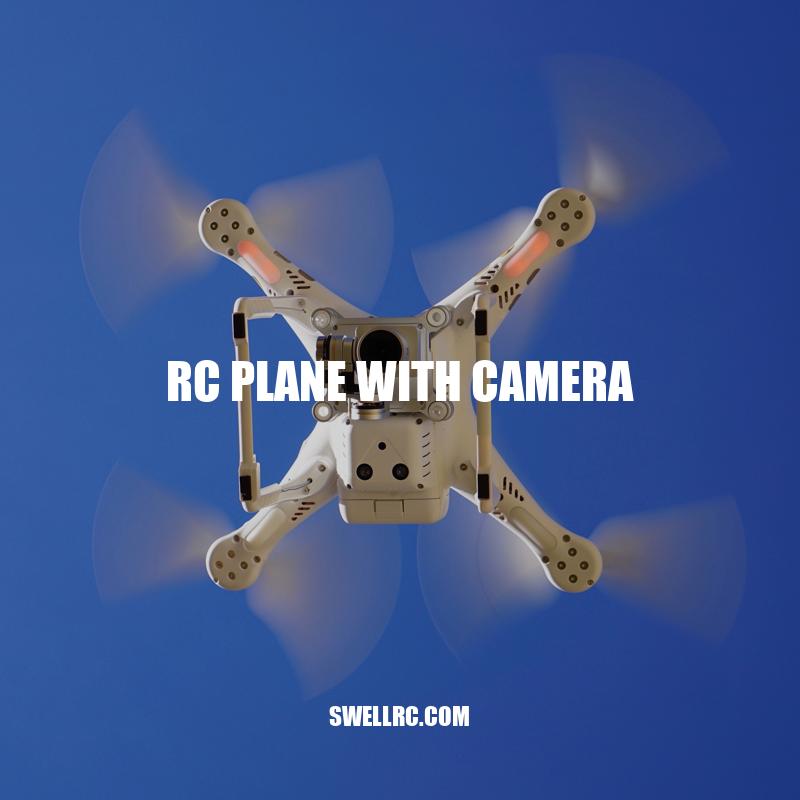RC Planes with Camera: A Comprehensive Guide.
Remote control (rc) planes with cameras have become increasingly popular in recent years due to advancements in technology. These planes are equipped with cameras that offer a unique perspective and are perfect for aerial photography and videography. There are various types of rc planes available, including drones, fixed-wing planes, and gliders. Each type has its advantages and disadvantages depending on the intended use. The different camera options available include GoPros and dedicated cameras, and camera quality and resolution are essential factors to consider for quality aerial footage. Flying rc planes with cameras requires proper techniques and safety considerations, such as flying in areas with minimal wind and adhering to local regulations and permits. With numerous applications, such as mapping, surveying, and wildlife observation, rc planes with cameras offer a cost-effective and accessible solution for hard-to-reach areas. The potential for continued growth and innovation in this field is vast, with emerging trends such as the use of artificial intelligence in rc planes.
Types of RC Planes with Cameras
There are various types of RC planes with cameras, each with their own unique features. Some of the popular types are:
- Drones: Multicopters that can hover in place and fly in various directions. Cameras can be mounted on the body or be stabilized by a gimbal.
- Fixed-Wing: Planes that have rigid wings and require takeoff and landing from a runway. Fly longer distances and higher altitudes than drones. Cameras can be mounted on the fuselage or belly of the plane.
- Gliders: Planes that are launched by hand and rely on thermal currents to stay airborne. Fly for extended periods and cover long distances. Cameras can be mounted on the cockpit or fuselage of the plane.
Depending on the intended use and environment, one type of RC plane may be more suitable than another. A beginner may prefer a drone for its ease of use and hovering capability, while a professional may opt for a fixed-wing or glider for its speed and range.
Popular models include the DJI Mavic Air 2 drone, the E-flite Convergence VTOL fixed-wing plane, and the HobbyZone Radian XL glider.
What are some popular models of RC planes with cameras?
Some popular models of RC planes with cameras include the DJI Mavic 2, Parrot Bebop 2 Power, and the Holy Stone HS100D.
When choosing a camera for your RC plane with camera, there are certain specifications to consider. These include:
- Resolution: The camera’s ability to capture fine details. Higher resolutions result in sharper and clearer images.
- Field of View (FOV): The angle of view captured by the camera. Larger FOVs are ideal for capturing expansive landscapes or group shots.
- Stabilization: Reduces camera shake and produces smoother footage. Can be achieved through a gimbal or electronic stabilization.
- Frames Per Second (FPS): The number of frames the camera captures per second. Higher FPS results in smoother video playback.
- Low-light Performance: The camera’s ability to capture clear images or video in low-light conditions.
- Size and weight: Consider the size and weight of the camera in relation to the RC plane’s payload capacity.
Some cameras are specifically designed for RC planes, such as the RunCam 2 camera. It is lightweight and compact, making it ideal for RC planes, and has a wide operating voltage range. It also has electronic image stabilization and records video at 1080p/60fps.
What is the recommended FPS for a camera used on an RC plane with camera?
There is no definitive recommended FPS for a camera used on an RC plane with a camera as it depends on the specific purpose and desired outcome of the footage. However, most cameras capable of recording aerial footage offer frame rates ranging from 24-60 fps.
Flying techniques and safety considerations
- Flying Conditions: Aim to fly in optimal weather conditions such as on a calm day with good visibility.
- Location: Select an area that has plenty of space to give you enough room to fly your rc plane with camera safely.
- Drone No-Fly Zones: Take care not to fly into any no-fly zones, such as near airports or over a crowd of people.
- Permits and Regulations: Make sure you have all the necessary permits and licenses required by your local regulations.
- Charging and battery: Follow the drone manufacturer’s instructions on how to charge the battery.
- Pre-flight checks: Ensure the rc plane’s camera and additional parts are connected securely before flight.
When flying with an rc plane with camera, there are certain techniques and safety considerations to keep in mind. These include:
- Avoid flying the rc plane in areas with excessive wind or tight spaces.
- Avoid obstacles like buildings, trees, and overhead power lines.
- Maintain a line of sight with the rc plane with camera to avoid a potential crash.
Safety considerations:
- Flying a drone into a no-fly zone or unauthorized airspace is against the law. Refer to your local regulations to determine the no-fly zones in your area.
- Ensure that your drone is equipped with a return-to-home feature, which automatically returns the drone to its takeoff location in case of signal loss or an emergency.
- Practice flying in open, unpopulated areas if you are a beginner. Improper piloting can cause the drone to crash and injure people or damage property.
- Regular maintenance of the drone and its parts is essential to ensure its continued safe operation.
Before you take flight, it is important to check the rc plane’s camera and additional parts, such as cables, batteries, and memory cards, to ensure that everything is working correctly. Follow the drone manufacturer’s instructions on battery charging, to avoid any accidents and check your rc plane with camera before every flight.
What are some flying techniques and safety considerations to keep in mind when using an rc plane with camera?
Flying techniques for using an RC plane with a camera include maintaining line of sight, practicing in open areas, avoiding obstacles, and being aware of the plane’s battery life. Safety considerations include using a checklist before flying, following FAA regulations, and being mindful of the weather conditions.
Rc planes with cameras have numerous applications that can be beneficial for different purposes. Here are some of the common applications:
Aerial Photography and Videography: Use rc planes with cameras to capture breathtaking images and videos from unique perspectives that are otherwise difficult to achieve. Rc planes can fly higher than the usual camera tripod, making them great for creating panoramic shots and sweeping aerial footage.
Mapping, Surveying, and Inspection: Rc planes with cameras can be equipped with high-resolution mapping and surveying equipment, making it easier to create detailed maps and survey reports in less time and cost-effectively. They can also be used to inspect buildings, pipelines, and power lines, particularly in areas that are hard to reach with ladders or scaffolding.
Wildlife Observation: Rc planes with cameras can be designed to observe wildlife and track animals, enabling researchers to collect useful data on their movement or behaviors in their natural habitats without disturbing their surroundings.
Search and Rescue Operations: Rc planes with cameras can be useful in finding people in remote locations. Survivors of natural disasters, people lost in the wild, and those in distress can be found more quickly with the help of an rc plane.
Many industries, including photography, film, agriculture, surveying, and research have integrated rc planes with cameras into their operations. There are several websites and products you can find online that cater to drone users and enthusiasts. There are also well-known brands of rc planes with cameras available in the market.
What are the different industries that use rc planes with cameras?
Some industries that use RC planes with cameras include film and television production, surveying and mapping, construction and engineering, agriculture, and wildlife conservation.
The future for rc planes with cameras looks exceptionally promising, with possible advancements in technology that could further enhance its capabilities. Here are some possible areas where there might be growth or change:
Improved Stabilization: Improved stabilization technology will be at the forefront of developing future rc planes. With smoother video footage in demand, stabilization advancements are crucial.
Increased Range: Advancements in batteries and autonomy can extend the range of future rc planes, allowing users to cover a larger distance in a single flight.
Artificial Intelligence: There is a possibility that rc planes with cameras might include AI technology for autonomous and obstacle-free flight.
Enhanced Camera Capabilities: Progress in camera technology may offer better image quality, more extended zoom, better dynamic range, and more.
Limited Access: Drones or rc planes with cameras may face a potential legal drawback where there could be airspace restrictions, ultimately limiting use on a professional level.
The rc plane with camera industry is growing, and there are several websites and products you can find online that cater to drone users and enthusiasts. Stay up-to-date with technological advancements and regulatory laws surrounding rc planes with cameras to stay ahead of the competition.
What advancements in battery technology could potentially improve the range of rc planes with cameras?
Advancements in lithium-ion battery technology and development of higher energy density cells could potentially improve the range of RC planes with cameras.
Conclusion
In conclusion, rc planes with cameras open up a world of possibilities for aerial photography, videography, and other applications. With the ongoing advancements in technology, it’s clear that the future of rc planes with cameras is extremely promising. However, it’s also important to keep in mind the safety and legal considerations of using rc planes with cameras that will affect professional and hobby flights.
If you’re interested in flying rc planes with cameras, take the time to research the various models and camera options to find what’s best suited for your needs. Be sure to follow proper safety measures and adhere to local regulations to avoid any legal complications.
Whether you’re a hobbyist or a professional, rc planes with cameras offer unique opportunities to capture stunning visuals and conduct aerial surveys and mapping. As the technology continues to grow, it’s exciting to think about what the future holds for this industry.



